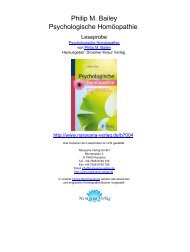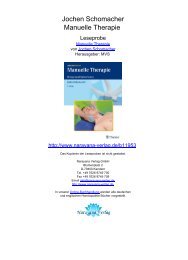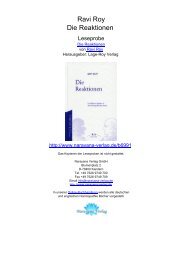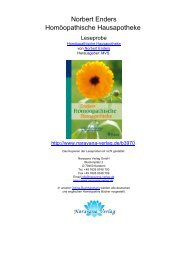Jo Evans Sea Remedies
Jo Evans Sea Remedies
Jo Evans Sea Remedies
Create successful ePaper yourself
Turn your PDF publications into a flip-book with our unique Google optimized e-Paper software.
Acanthaster planci<br />
starfi sh is about one centimetre in size and begins to feed on corals. It becomes<br />
sexually mature at the end of its second year, by which time it has grown to about<br />
twenty centimetres in diameter.<br />
It is not known how long this species lives, but they have been kept in aquaria<br />
for as long as eight years. Growth rate and reproduct ion rates decline after three<br />
to four years.<br />
Movement: Crown of thorns starfi sh walk on large numbers of tiny tube feet situated<br />
in the grooves running along the underside of their arms. Th ese act like hydraulic<br />
suckers, operating by means of water pressure in the central cavity and tubes. Th e<br />
arms are muscular and strong, allowing the starfi sh to walk across the sea fl oor, as<br />
well as navigate the reef; they can move in reverse, turn around and move individual<br />
arms independently (Perrins and Middleton, 1985).<br />
Defending: Crown of thorns starfi sh are armoured with impressive spines, off ering<br />
a strong deterrent to attackers. However, a number of animals are known to attack<br />
and prey on crown of thorns starfi sh, notably the giant triton, and also certain molluscs,<br />
fi sh, crustaceans and the fi reworm.<br />
Senses: Chemical messaging (smelling and tasting). Touch. Photoreceptors.<br />
Balance. 11<br />
Signature and Symbol<br />
Th e crown of thorns starfi sh is spiky, sinister-looking and venomous; its threatening<br />
image provokes an immediate sense of danger. Th ey are known as the plague of the<br />
coral reefs, systematically eating their way through large areas of reef, destroying<br />
everything in their wake. Th is not only kills the living coral polyps but the infrastruct<br />
ure of vast numbers of reef species that depend on the coral for their habitat.<br />
Reefs can take up to two decades to regenerate. Th e imbalance is thought to have<br />
occurred largely as a result of over-harvesting the triton shell; the triton is the main<br />
predator of the crown of thorns starfi sh.<br />
Signature<br />
o Poisoning symptoms were borne out by the proving: itching, swelling, heat,<br />
oedema, reddening, numbness, stiff ness of muscles and infl ammation of<br />
lymph glands.<br />
o<br />
o<br />
Th e ‘thorns’: stabbing, stitching, pricking pains.<br />
Destruct iveness of coral reefs, digesting the polyps alive: the delusions of necro-<br />
sis, necrosis of the brain, of the brain dissolving. Fear of disease, cancer.<br />
11 [www.aims.gov.au/pages/refl ib/cot-starfi sh/pages/] Last accessed Oct ober 2008, and Kosarek, N. 2000.<br />
“Acanthaster planci” (On-line), Animal Diversity Web. [http://animaldiversity.ummz.umich.edu/site/accounts/<br />
information/Acanthaster_planci.html] Last accessed Oct ober 2008.<br />
Acan-p.<br />
STARFISH & SEA URCHINS<br />
ECHINODERMS<br />
271

















